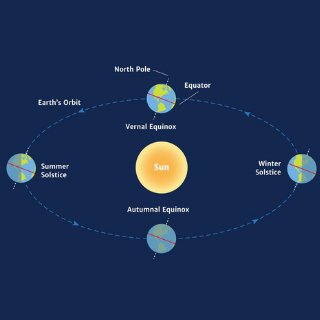
This science and culture lesson is designed for 3 to 6-year-old children to guide them about the concepts of seasons, solstices, and equinoxes.
This lesson introduces the child to the variations in lengths of day and night and the change in seasons. It talks about the two types of solstices and equinoxes, which mark the changes in a day’s length and the seasons.
This video lesson uses diagrams and illustrations to help the child understand the science concepts better.
Seasons on earth change during four specific times each year.
- July and December represent solstices.
- March and September represent equinoxes.
Let us understand what is solstice and equinox and the difference between them:
What are Equinoxes (Vernal & Autumnal)?
The earth’s axis is tilted neither towards nor away from the sun only twice a year, resulting in equal daylight and darkness at all latitudes. These events are called equinoxes. Equinox is derived from two Latin words: Equus (equal) and nox (night).
At these two equinoxes, the sun is directly overhead at noon at the equator. Refraction of the sun’s rays or the bending of light’s rays causes the sun to appear above the horizon when it is actually below it.
In addition, the days are a little longer at the higher latitudes (those far from the equator) because the sun takes longer to rise and set.
During the equinox and for several days before and after, the length of the day is approximate:
- 12 hours and 6 and one-half minutes at the equator
- to 12 hours and 8 minutes at 30 degrees latitude,
- to 12 hours and 16 minutes at 60 degrees latitude.
What are Solstices (Summer & Winter)?
During the summer solstice, the tilt of the earth’s axis toward the sun is at its maximum. The sun appears at its highest elevation on the summer solstice day, and its position at noon changes very little for several days before and after. This event occurs when the sun passes directly over the Tropic of Cancer, located at 23.5° latitude north, and runs through Mexico, the Bahamas, Egypt, Saudi Arabia, India, and southern China.
At the winter solstice, the days are the shortest, and the nights are the longest. The sun is directly overhead the Tropic of Capricorn, located at 23.5° south of the equator, and runs through Australia, Chile, southern Brazil, and northern South Africa.
How are Season Equinox and Solstice Related?
The seasons on the earth occur due to a tilt on its axis or axial tilt by 23° and the rotation of the earth. Because of this indiscretion, during certain parts of the year, the Southern Hemisphere is slightly more exposed to the sun’s rays, and vice versa. It causes various effects on our planet, including significant temperature shifts and meteorological changes, and more or less light and energy coming from the sun or seasons.
Watch the video to learn more about the science behind the change in seasons.
Related Video Lessons:
For more arts and crafts resources, visit: https://theglobalmontessorinetwork.org/science-resources/
Video Created by: Justine McNeilly
Tags
- English
- montessori
- primary
- science





